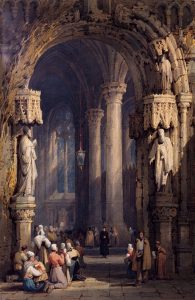Introduction
A year and a half ago, I embarked on my first college philosophy class titled “A History of the Self” at the University of Texas at Austin. As a part of the Plan II Honors Program, an interdisciplinary major and an honors program, I was required to take a one-semester signature course my freshman year of college. While being excited and overwhelmed by the array of choices, “A History of the Self” piqued my interest due to the inquisitive nature of the course description and the extensive reading list mainly focused on the European intellectual movement. The course description promised an exploration into the nature of the human self, whether the self exists in a material or an immaterial realm, and the long-winded debate about the malleability of the self over time with thoughts and actions. In this article, I will discuss my experience with the class and highlight the main takeaways.
To begin, the biweekly discussions spanned over a semester and explored some of the works of Nick Mansfield, Jerrold Seigel, Ian Hacking, René Descartes, Friedrich Nietzsche, Sigmund Freud, Virginia Woolf, Jacques Lacan, Frantz Fanon, Michel Foucault, Gilles Deleuze, Félix Guattari, Audre Lorde, and Gloria Anzaldúa. Each week was dedicated to reading a selected work from one of the authors, and the students were tasked with summarizing their insights through discussion boards, papers, and delivering a final presentation on their chosen philosopher.
Unlike big lecture hall classes at UT Austin, the Plan II signature classes fostered a more intimate setting with only ten to fifteen students per signature course. “A History of the Self” discussions were guided by Dr. Tracie Matysik, who masterfully employed the Socratic method and fostered profound and engaging discussions. The course was both insightful and transformative, as it encouraged the students to develop their own conception of the human self in addition to understanding how the philosophical perspectives of the human self have evolved over time.
Mansfield and Seigel: The Contrasting Views of the “Self” and Its Inner Complexities
The class’s first encounter with the philosophical understanding of the human self came from reading excerpts from Australian philosopher Nick Mansfield’s Subjectivity: Theories of the Self From Freud to Haraway. Our first-class discussion was lively and began with conversations about everybody’s preliminary examinations of selfhood. Everyone had a different conception of what the human self was—whether it was corporeal, spiritual, or intellectual—displaying the diverse perspectives that each student brought to the table. These different conceptions sparked an engaging debate on whether the human self was something that was socially constructed or whether it was an innate characteristic.
Even with diverse opinions, the class found commonality in Mansfield’s definition of subjectivity. According to Mansfield, subjectivity is defined as “an abstract or general principle that defies our separation into distinct selves and that encourages us to imagine that, or simply helps us to understand why, our interior lives inevitably seem to involve other people, either as objects of need, desire and interest or as necessary sharers of common experience.” Looking back, this was central to our future discussions, as it combined the idea that the self is both a social construction and an intrinsic characteristic, encouraging us to explore the interconnection between these two things.
After leaving class with an interesting intersection in our minds, we were assigned to read Chapter 1 of The Idea of the Self by the American historian, Jerrold Seigel. In our next class discussion, we discussed how selfhood shapes our “personal existence and our relations with those whose lives we somehow share.” This definition sounded very similar and brought our discussion back to Mansfield’s interpretation of subjectivity, leading us to discuss how the self was not merely intrinsic nor solely socially constructed, but something that is a combination of both. These lively discussions and debates affirmed our beliefs on the self and prepared us to dive into the famous conceptions of the self represented by various thinkers.
Decoding Descartes: “I think, I exist” and the Machinations of Thought
“Cogito, ergo sum” was the phrase we explored in relation to René Descartes and his meditations. After reading the first meditation, the essence of doubt was prevalent in our lectures as we discussed its significance in challenging our perceptions of reality. The concept of doubt was fundamental to Descartes’ theory of existence and sparked vivacious debate among the students. Some argued that doubt was sufficient enough to establish self-awareness, while others argued that doubt alone cannot constitute existence.
To resolve this complex dilemma, Dr. Matysik guided the class through a thought experiment, similar in spirit to Descartes’ own skepticism. We were asked to imagine a malicious being capable of deceiving us about the nature of reality through the creation of an illusion of the world around us. This activity, drawing upon Descartes’ meditation on being deceived by an “evil demon,” attempted to cast doubt on the very nature of existence. Hence, it encouraged students to question their sense of reality and consider the modern notion of simulation theory.
As the vibrant discussion continued, a student asked a pivotal question that reshaped the way we thought: if the “evil demon” was real and we cannot trust our senses, could anything truly be known for certain? This question revealed the power of Descartes’ method of radical doubt and led us to Descartes’ proclamation in the second meditation, where he claims that “I know something certain, or, if nothing else, until I at least know for certain that nothing is certain.” This critical moment led the class to understand that while we cannot be certain of anything beyond thought, the act of doubting itself substantiates one’s existence.
Slowly, Descartes’ argument became clearer, illustrating that the contemplation of one’s existence proves that one exists. Thus, bringing us full circle to the foundational phrase “Cogito, ergo sum,” which helped illuminate the interplay between doubt and thought. It is through doubt and certainty of thought that Descartes emphasized the very essence of existence and what it means to question one’s own reality.
Narrating Nietzsche: Re-evaluating the “Good,” the “Bad,” and the “Evil”
After establishing that thought verifies existence and the human mind is a key aspect of the self in the Cartesian lens, we delved into the work of German philosopher Friedrich Nietzsche by reading On the Genealogy of Morality. I was first introduced to Nietzsche during the summer of 2020 when I started learning about philosophy; I have had a fascination with his work ever since. To explore my newfound interest in the field, I attended the 2020 Iowa Lyceum virtually, which greatly enhanced my understanding of philosophy. Additionally, I delivered my final presentation on an “Introduction to Nietzsche’s philosophy.” When I was enrolled in my signature class, “A History of the Self,” three years later, my fascination with Nietzsche’s philosophy was very much still alive, and I had the opportunity to conduct in-depth research and deliver my final presentation on The Genealogy of Morality.
Our class discussion with Nietzsche began with the exploration of morality through the binary of “good” and “bad.” Before delving into the text, the class began by defining what their individual conception of morality was and examining how contemporary society categorizes morally good actions and morally bad actions. As students started sharing their thoughts, the class collectively started to realize that the contemporary view on morality was different from how morality was defined through the Nietzschean lens. For many of us, reading Nietzsche was an eye-opening experience that challenged us to reconsider our own values and how we define them.
Nietzsche’s definition of “good” as the “noble, powerful, higher-ranking, and high-minded who felt and ranked themselves and their doings as good” and “bad” as “base, low-minded, common, and vulgar” served as a nexus point of deeper philosophical exploration; something that is “good” is related to the upper traits of nobility while something that is “bad” is defined as the direct opposition to those “good” characteristics. This discussion served as a springboard for our exploration of master morality in relation to the good-bad binary and slave morality, which occurs when the person in the weaker position deems the person in the stronger position “evil” due to their higher standing. We learned that this creates a sense of ressentiment where the person in the weaker position resents their opposition, and they “recover their losses only through an imaginary revenge.” This distinction caused the class to reconsider the contemporary definitions of “good,” “bad,” and “evil,” and their role in conceptualizing morality.
After several deliberate discussions and vibrant debates, the class started to realize that Nietzsche’s critique was not solely about morality but offered a deeper exploration of the human self. With the guidance of Dr. Matysik and the synthesis of everyone’s insights, the class began to interpret Nietzsche’s argument as describing the self as something that is not based on a static model of morality but as a dynamic entity that evolves over time due to a variety of experiences, actions, and subjective perspectives. Nietzsche’s moral philosophy and his conception of the self allow for the deconstruction of the traditional moral binary and advocate for the fulfillment of one’s true potential through the continual reevaluation of one’s beliefs and values. Delving into Nietzsche was deeply transformative and illuminated a path of self-discovery, critical thinking, and intellectual growth. Nietzsche showed our class that philosophy was not merely an exploration of ideas but an exploration of what it means to be human.
Finding Freud: Unveiling Civilization and Its Discontents
After exploring Nietzsche’s conception of morality, we transitioned to Freud’s Civilization and Its Discontents, which deepened our understanding of psychoanalysis and further shaped our conception of the self.
Our exploration of Freud began with defining “civilization.” Students shared diverse interpretations of what it entails and how it has evolved over time. As the discussion progressed, we found ourselves aligning with Freud’s definition of civilization as “the whole sum of the achievements and the regulations which distinguish our lives from those of our animal ancestors and which serve two purposes—namely, to protect men against nature and to adjust their mutual relations.”
This duality sparked a lively debate on repression and redemption. We questioned whether civilization simultaneously enables and restricts behavior and explored the tension between intrinsic desires and societal expectations. These questions underscored a key aspect of the class: philosophical narratives were not merely theoretical but deeply relevant to the societies we inhabit and our roles within them.
These engaging discussions extended over several classes as our focus shifted from civilization to the self, leading us to explore the id, ego, and superego. Many of us were familiar with Freud’s tripartite model, but we had not previously examined its philosophical context. Through discussions and debates, we explored the dynamic interplay between the id, ego, and superego, reshaping our understanding of the self. The id represents instinctual drives, the superego embodies societal constraints, and the ego mediates between the two.
This interplay led us to a full-circle moment, connecting back to Mansfield and Seigel’s view of the self as fragmented yet united by shared needs and interests. This exploration not only deepened our understanding of Freud but also prompted reflection on the deeper conflict between inner drives and societal constraints. Ultimately, we reconceptualized the self—not as a simple product of societal norms and instincts, but as the result of a complex interplay of tensions that sustain both civilization and our inner world.
Conclusion: Overall Thoughts and Key Takeaways on the Human Self
After a vibrant first semester of “A History of the Self,” marked by the exploration of diverse philosophical works, the class had amassed a wealth of knowledge about the human self, refining our initial definitions of what we believed constituted it at the start of the semester. As the course came to an end, I found myself returning to the questions that had intrigued me from the beginning: Is the human self material or immaterial? Does it change over time, or does it remain stagnant throughout one’s life? And can we ever arrive at a definitive conception of what constitutes the human self?
To explore these questions, I drew upon our class discussions and debates on the self, engaging with the works of Descartes, Nietzsche, Freud, and many others. Whether it was the Cartesian idea that thinking verifies existence, Nietzsche’s notion of societal structures offering redemption from moral binaries, or Freud’s depiction of the self as caught in conflict between instinctual desires and societal norms, I began to grasp that the self is a deeply intricate and subjective concept.
Most notably, on the last day of class, Dr. Matysik asked us to share our conception of the self after reading the perspectives of multiple philosophers throughout the semester. Students offered refined answers, drawing from the philosophers we had studied and discussed. As my classmates shared their insights, I began to reflect and realized that the human self is an ever-evolving, immaterial entity shaped by both internal and external factors. I came to see the self as both repressed by societal norms and simultaneously seeking redemption as it defines itself in a world of competing values and beliefs. Thus, the self is constructed through personal introspection and external realities, as the journey of self-definition is continuous, shaped by the larger question of what it means to be human in a constantly changing world.
Walking out of class that day, I knew that even if my conception of the self was flawed, I had learned one important lesson: to look within, one must first look outside. Even now, this class holds significant importance in my academic journey, as I continue to observe connections between its material and my daily life. The ideas explored in “A History of the Self” remain deeply relevant, as concepts of identity, morality, and societal norms are ever-present in our interconnected world. By examining these ideas through a philosophical lens, we gain a more nuanced and meaningful understanding of the self—one that helps us reflect on our existence within the broader context of personal growth and societal progression.
The post Insights from “A History of the Self” first appeared on Blog of the APA.
Read the full article which is published on APA Online (external link)







